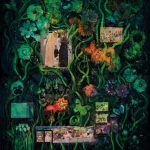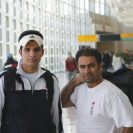For artist Shurooq Amin, her latest series titled It’s a Mad World arrives full circle since her last exhibition in Kuwait. A true believer in self-progress and evolution, the artist might feel some apprehension prior to her upcoming show at CAP (Contemporary Art Platform) Kuwait, yet she is mostly excited to share her work with her local community. Since the shut down of It’s a Man’s World four years go, Shurooq has been wonderfully represented by Ayyam Gallery, giving her a platform to raise her voice uncensored and showcase her work in both Dubai and London. We couldn’t deny our elation and pride, however, when we learned about Ayyam Gallery’s recent endeavor with CAP Kuwait to exhibit Shurooq’s It’s a Mad World. A showcase of Shurooq’s work in Kuwait marks a creative milestone not only for the artist, but for anyone who believes in art and its importance.
It’s a Mad World consists of 18 artworks and an installation, and is curated by the renowned Martina Corgnati. Like all of Shurooq’s work, literature plays a key role in the development of her pieces. In It’s a Mad World, titles of various literatures are twisted to convey the purpose of the series of work itself. She explained, “It started subconsciously with Society Girls in 2010. In Society Girls I wrote a fusion of my poetry and Nizar Qabbani’s poetry onto the canvases as part of the background. Then slowly the words left the canvas and became significant in the titles as in It’s a Man’s World (2012), in Popcornographic (2013), in We’ll Build This City on Art and Love (2014), and at the Venice Biennale in 2015. The titles became my way of connecting the image to the message in an even more sarcastic, ironic way. I suppose having a PhD in Ekphrasis (the connection between art and poetry) has influenced my work as an artist.” We sat down for a quick chat with the Shurooq to learn more about her upcoming exhibition at CAP Kuwait.
How does it feel to exhibit your work once again in Kuwait?
Thank you! I’m very happy and excited, but also slightly apprehensive. When people ask me if I think there might be trouble, I say that lightening doesn’t strike in the same place twice. Then they say it could strike three times! But on a serious note, Kuwait has come a long way since then. There are three factors involved in this: First, I think Kuwait is ready for me now. When I exhibited It’s a Man’s World in 2012, with its transparent portrayal of the hidden lives of men in Arab society, the country was not ready for those images. But since the shut down of that show and censorship of my work, many younger artists began to be more brave and explore society’s taboo issues, as I opened the door for them, so to speak (that was the second factor, that more artists in the region began to tackle sensitive subjects). Thirdly, in addition to that, I have proven myself as a fixture in the art world. My work is consistent and I am evolving not only as an artist technically and conceptually, but also as a human being in giving back to the community and in using my work as a vehicle for change.
Why did you change the original title for the show?
The title was supposed to be Apocalypso Now, because I had a dream of Ed Sheeran singing his “I See Fire” song to my title. But then, after living with it for a few months, the title organically transformed into It’s a Mad World. There was a phonetic and syntactic connection to the title of It’s a Man’s World which was shut down in Kuwait four years ago, and since this was my Kuwait comeback show, so to speak, it seemed very poetic and relevant.
Can you tell us more about your inspiration behind It’s a Mad World?
Like all of my other series it grows out of the previous one, like a lizard’s limb. They are all connected. It depends on what is happening around me in the world: my world, your world, the world on the news. The installation, The Last Sip, for example, is extremely relevant and timely for me. Geographically, it is also site-specific, as it explores the damaging ramifications of alcoholism in a society where alcohol is forbidden.
How is the work different this time?
First, it is technically better, as my craft keeps evolving every year. Second, it is conceptually more global and powerful. I brought Syria (the destruction of the cities), Chernobyl (the 1989 catastrophe and subsequent abandonment) and Taima (the area in which the bidoon live in Kuwait) into it as backgrounds for juxtaposing the madness of our world today.
The exhibition is curated by Martina Corgnati. Would you say that the time you spent with Martina at the 56th Venice Biennale greatly influences the direction of this exhibition?
My time at the Venice Biennale was very inspiring, and my time with Martina at the Biennale was very influential. To be surrounded by greatness means you absorb some of it and become inspired. Martina and I clicked right away (she is an incredibly beautiful soul and has a balance to her, a grounded-ness that is contagious). So when she suggested that she would like to work with me, it seemed only natural that she should curate my show.
How do you spend your time between exhibitions, and what does it take for you to start working on another artwork?
Good question. For me to start working on another exhibition is easy. Like I said previously: Once the concept is finished for this one, and the message is complete for this series, then I get ideas and screams in my head that need to be heard so I write them down or sketch them in my notebook (every series has a separate notebook). If I don’t write them down, I would go mad. I need to physically extricate them out of my brain, so that I can be at peace. About three months later, I usually start itching to get back into the studio because the conceptual part of my process is done. This takes about three months. Then there are six full months of actual studio work that could take anywhere between 6-12 hours a day. I do everything manually, there is no Photoshop used in any of these paintings. I do the photo shoots myself, then printing, then collaging manually, then adding layers of images via acrylic painting until the final message/image is ready to be varnished. I do not worry about where it will be exhibited; I do not worry about how it will be perceived; I just do the work that needs to be done, and say what needs to be said.
What’s next for Shurooq Amin?
That’s a loaded question: I am already conceptualizing my next show, believe it or not. No idea where it will be exactly, but pretty sure it will be with my representative gallery, Ayyam Gallery in Dubai, for 2017. Events that are already in my calendar: for 2016, I am invited to be a PhD examiner at a university in Italy, a speaker at a conference in a university in Italy, I have a long artist residency in Italy in the summer, then a show in Cairo, another biennale that I cannot speak about yet, and a couple of speaking engagements. So it is a very busy productive year for me. Bring it on.
It’s a Mad World, a solo exhibition by Shurooq Amin curated by Martina Corgnati, is scheduled to take place on April 9 at CAP Kuwait. For more information, visit shurooqamin.com, follow the artist on Twitter and Instagram @shurooqamin and Facebook: Shurooq Amin.













